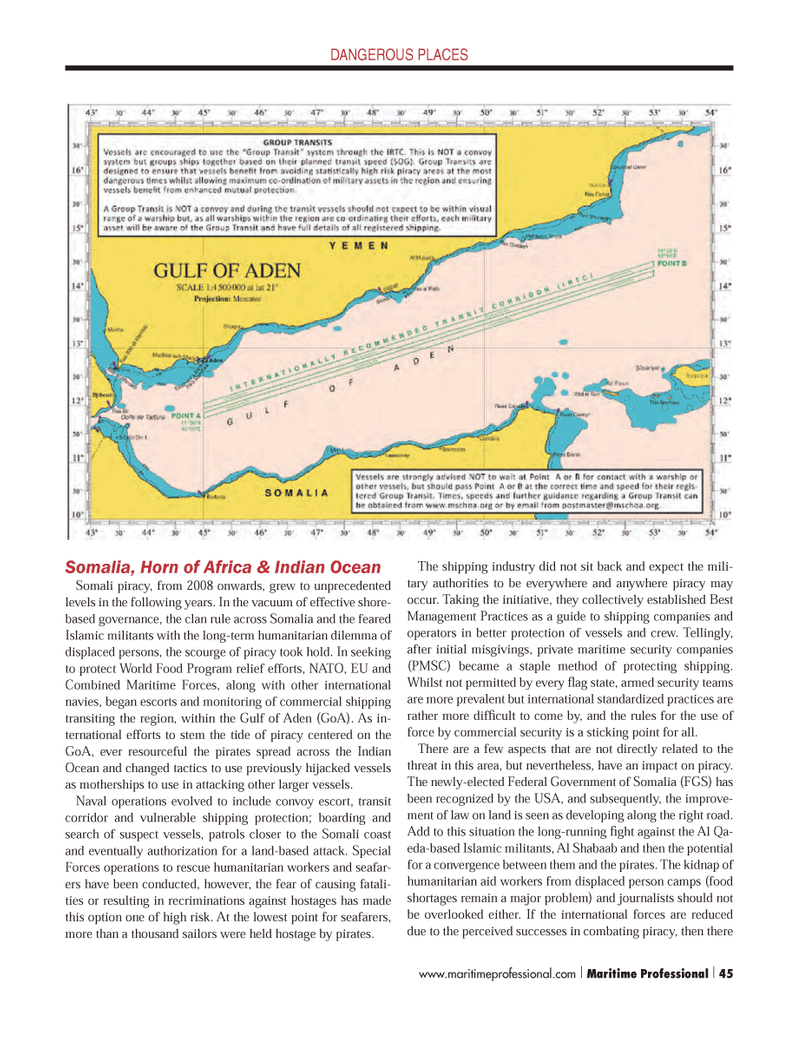
Page 45: of Maritime Logistics Professional Magazine (Q1 2013)
Maritime Risk
Read this page in Pdf, Flash or Html5 edition of Q1 2013 Maritime Logistics Professional Magazine
Somalia, Horn of Africa & Indian OceanSomali piracy, from 2008 onwards, grew to unprecedented levels in the following years. In the vacuum of effective shore- based governance, the clan rule across Somalia and the feared Islamic militants with the long-term humanitarian dilemma of displaced persons, the scourge of piracy took hold. In seeking to protect World Food Program relief efforts, NATO, EU and Combined Maritime Forces, along with other international navies, began escorts and monitoring of commercial shipping transiting the region, within the Gulf of Aden (GoA). As in- ternational efforts to stem the tide of piracy centered on the GoA, ever resourceful the pirates spread across the Indian Ocean and changed tactics to use previously hijacked vessels as motherships to use in attacking other larger vessels. Naval operations evolved to include convoy escort, transit corridor and vulnerable shipping protection; boarding and search of suspect vessels, patrols closer to the Somali coast and eventually authorization for a land-based attack. Special Forces operations to rescue humanitarian workers and seafar- ers have been conducted, however, the fear of causing fatali- ties or resulting in recriminations against hostages has made this option one of high risk. At the lowest point for seafarers, more than a thousand sailors were held hostage by pirates.The shipping industry did not sit back and expect the mili- tary authorities to be everywhere and anywhere piracy may occur. Taking the initiative, they collectively established Best Management Practices as a guide to shipping companies and operators in better protection of vessels and crew. Tellingly, after initial misgivings, private maritime security companies (PMSC) became a staple method of protecting shipping. Whilst not permitted by every ß ag state, armed security teams are more prevalent but international standardized practices are rather more difÞ cult to come by, and the rules for the use of force by commercial security is a sticking point for all.There are a few aspects that are not directly related to the threat in this area, but nevertheless, have an impact on piracy. The newly-elected Federal Government of Somalia (FGS) has been recognized by the USA, and subsequently, the improve- ment of law on land is seen as developing along the right road. Add to this situation the long-running Þ ght against the Al Qa- eda-based Islamic militants, Al Shabaab and then the potential for a convergence between them and the pirates. The kidnap of humanitarian aid workers from displaced person camps (food shortages remain a major problem) and journalists should not be overlooked either. If the international forces are reduced due to the perceived successes in combating piracy, then there DANGEROUS PLACES www.maritimeprofessional.com | Maritime Professional | 45MP #1 34-49.indd 45MP #1 34-49.indd 452/22/2013 11:23:17 AM2/22/2013 11:23:17 AM

 44
44

 46
46
